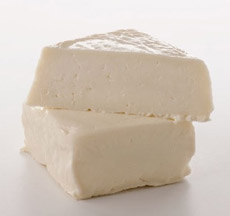TIP OF THE DAY: Hispanic-Style Cheeses & How To Use Them
|
In the past, Hispanic-style cheeses could be difficult to find in the U.S., often requiring a trip to a Mexican specialty food store.
But as with Mexican food in general, Hispanic-style cheeses continue to grow in popularity, with many varieties now available in mainstream supermarkets across the country. California is the country’s leading producer of Hispanic-style cheeses, followed by Wisconsin. You don’t need to wait for Cinco De Mayo to try them, but they’ll make the celebration more authentic. Thanks to the California Milk Advisory Board for this guide to domestic-made, Hispanic-style cheeses. Note that the names given here are the most common names for these cheeses. However, it is not uncommon for a Hispanic-style cheese to be called by more than one name. Also, some cheese makers sell their cheeses under a proprietary name. In most cases the names given here will be on the package. > The different types of cheese: a photo glossary. Fresh (unripened) cheeses are very young cheeses that have not been allowed to age. Typically, fresh cheeses are soft and moist, white or off-white in color. They have a shorter shelf life than aged cheeses and must be kept in the refrigerator. Many Hispanic-style cheeses soften but do not melt when cooked. Because they hold their shape when heated, they are often used as fillings or toppings in recipes. They also tend to have mild to pronounced saltiness, so require less salt added to recipes. You can find them in whole-milk or low-fat varieties. |
 [1] Braided Oaxaca cheese (photo © Cheese.com .
|
|
|
|
||
 [4] Crumbly Cotija cheese (the name means young or fresh) can be used like feta (photo © Bakeoff Flunkie).
|
AGED HISPANIC-STYLE CHEESES Aged Hispanic cheeses are made in semi-firm and firm styles. Some will soften but not melt when heated; others are excellent melting cheeses that add richness and creaminess to cooked foods. Aged cheeses have a longer shelf life than fresh cheeses. Store them in the fridge and handle them as you would Cheddar or Jack. Most are available in whole-milk or low-fat varieties. Note that “añejo” (aged) means something different in Hispanic-style cheeses: It is not analogous to American and European aged cheeses. Hispanic-style cheeses are aged to some degree, but their dry texture and pungent, sharp flavor come from being salted, pressed and dried rather than being aged for a long time. |
|
|
Latin cuisine can be spicy, but the cheeses are usually mild, providing a pleasant contrast. Dairy products also lessen the heat of fiery chile peppers*. When choosing a Hispanic-style cheese for cooking, keep these three categories in mind: *The casein (a protein) in dairy binds with the capsaicin (the heat component of chiles) to help wash it out of your mouth. |
||


